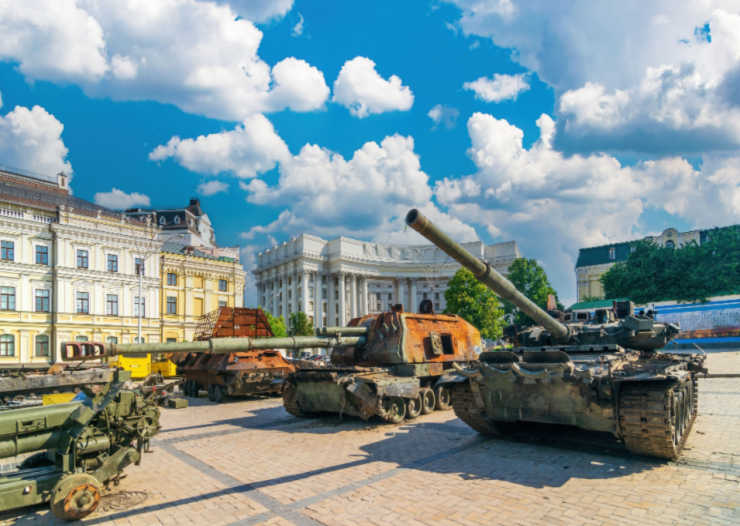
Captured Russian tank and self-propelled artillery destroyed during Russian invasion of Ukraine in 2022. Ukraine’s Ministry of Foreign Affairs building sits in the background. Kyiv, Ukraine. By Haidamac @ Shutterstock.com
At Foreign Policy, Marc R. DeVore suggests that Russia’s war economy is hitting its limits. He writes:
Now that Donald Trump is returning to a second term as U.S. president, ascertaining the true state of Russia’s war economy is more important than ever. Trump’s advisors believe that Ukraine must settle for peace by whatever means necessary “to stop the killing.” Implicit in this argument is the view that Russia has the ability to sustain the war for many years to come. On close examination of the evidence, however, the narrative that Russia has the resources to prevail if it so chooses does not hold.
The apparent resilience of the Russian economy has confounded many strategists who expected Western sanctions to paralyze Moscow’s war effort against Ukraine. Russia continues to export vast quantities of oil, gas, and other commodities—the result of sanctions evasion and loopholes deliberately designed by Western policymakers to keep Russian resources on world markets. So far, clever macroeconomic management, particularly by Russian Central Bank Governor Elvira Nabiullina, has enabled the Kremlin to keep the Russian financial system in relative health.
At first glance, the numbers look surprisingly strong. In 2023, GDP grew by 3.6 percent and is expected to rise by 3.9 percent in 2024. Unemployment has fallen from around 4.4 percent before the war to 2.4 percent in September. Moscow has expanded its armed forces and defense production, adding more than 500,000 workers to the defense industry, approximately 180,000 to the armed forces, and many thousands more to paramilitary and private military organizations. Russia has reportedly tripled its production of artillery shells to 3 million per year and is manufacturing glide bombs and drones at scale.
Despite these accomplishments, Russia’s war economy is heading toward an impasse. Signs that the official data masks severe economic strains brought on by both war and sanctions have become increasingly apparent. No matter how many workers it tries to shift to the defense industry, the Kremlin cannot expand production fast enough to replace weapons at the rate they are being lost on the battlefield. Already, about around half of all artillery shells used by Russia in Ukraine are from North Korean stocks. At some point in the second half of 2025, Russia will face severe shortages in several categories of weapons.
Perhaps foremost among Russia’s arms bottlenecks is its inability to replace large-caliber cannons. According to open-source researchers using video documentation, Russia has been losing more than 100 tanks and roughly 220 artillery pieces per month on average. Producing tank and artillery barrels requires rotary forges—massive pieces of engineering weighing 20 to 30 tons each—that can each produce only about 10 barrels a month. Russia only possesses two such forges.
In other words, Russia is losing around 320 tank and artillery cannon barrels a month and producing only 20. The Russian engineering industry lacks the skills to build rotary forges; in fact, the world market is dominated by a single Austrian company, GFM. Russia is unlikely to acquire more forges and increase its production rate, and neither North Korea nor Iran have significant stockpiles of suitable replacement barrels. Only a decision by China to provide barrels from its own stockpiles could stave off Russia’s barrel crisis.
To resupply its forces, Russia has been stripping tank and artillery barrels from the vast stockpiles it inherited from the Soviet Union. But these stockpiles have withered since the start of the war. Combining current rates of battlefield loss, recycling from stockpiles, and production, Russia looks set to run out of cannon barrels some time in 2025.
Russia is consuming other weapons, too, at rates far faster than its ability to produce them. Open-source researchers have counted the loss of at least 4,955 infantry fighting vehicles since the war’s onset, which comes out to an average of 155 per month. Russian defense contractors can produce an estimated 200 per year, or about 17 per month, to offset these losses. Likewise, even Russia’s expanded production of 3 million artillery shells per year pales in comparison to the various estimates for current consumption at the front. While those estimates are lower than the 12 million rounds Russian forces fired in 2022, they are much higher than what Russian industry can produce.
Read more here.
If you’re willing to fight for Main Street America, click here to sign up for the Richardcyoung.com free weekly email.




